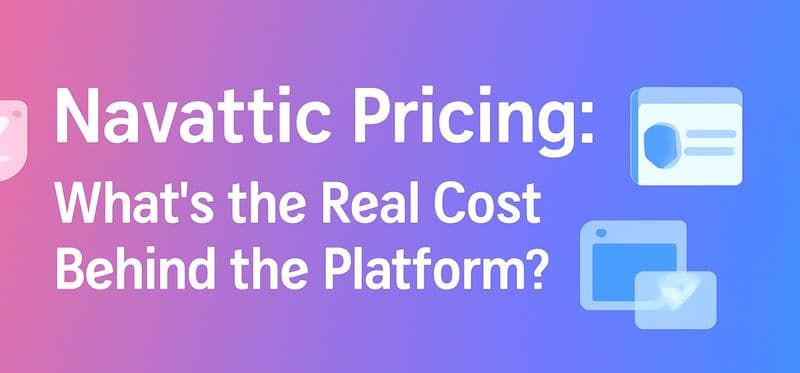
Implementing a SaaS solution can transform your business only if you get it right. Too often, companies dive in without a clear plan, only to face integration headaches, frustrated teams, and unmet goals.
Creating a SaaS implementation plan isn’t just about choosing the right software. It’s about aligning that software with your team’s needs, workflows, and more significant business objectives from the start.
With the right plan, you can avoid the pitfalls and set your team up for success. Whether you're a fast-growing startup or an established company, a clear, strategic implementation roadmap will help you hit the ground running and ensure you get the desired results.
Let’s break down the steps to build a SaaS implementation plan that works for your business.
But, What Is SaaS Implementation—And Why Founders Shouldn't Overlook It
Rolling out your SaaS product internally to your sales team or to your clients isn’t just about flipping the switch. Without a clear implementation plan, what should accelerate growth can quickly stall adoption, frustrate teams, and erode customer trust.
SaaS implementation is the structured process of integrating your software into daily workflows, covering everything from goal-setting and onboarding to training, configuration, and data migration. For SaaS founders, it’s the bridge between product promise and customer success.
Get it right, and you reduce churn, shorten time-to-value, and increase retention. Get it wrong, and you risk confusion, wasted spend, and lost deals.
What Are the Types of SaaS Implementation Process?

When you start using a SaaS platform, choosing the proper implementation process is essential to simplify the entire process. There are three main ways to do this, and each one helps with different business needs and the complexity of other SaaS tools.
1. Self-guided SaaS Implementation
For businesses with simple SaaS adoption needs, self-guided implementation is a fast and affordable choice. Think of it as DIY for SaaS:
Users follow step-by-step guides, product demos, and in-app tutorials at their own pace.
There are no complex changes or hand-holding, just a smooth, independent transition.
However, the user must stay engaged and learn how to use the new tool.
That said, having support channels like FAQs or discussion forums can help.
This method keeps things efficient and cost-effective for small teams or startups while offering the basics of a seamless transition.
2. Enterprise SaaS Implementation
Enterprise SaaS implementation is designed for large-scale businesses where software integration drives operations. It’s a team effort:
Project managers, IT, and key stakeholders must collaborate closely to ensure everything runs smoothly.
Take Salesforce as an example—a CRM that needs deep customization to align with company needs.
Security, data integration, and specialized training are all crucial.
With the right approach, enterprise SaaS implementation ensures the software fits ideally and meets high standards, helping large teams stay productive and compliant.
3. Hybrid SaaS Implementation
Hybrid SaaS implementation combines the best of both worlds: self-guided learning and business-focused support. It’s perfect for companies looking to:
Scale while keeping their teams engaged.
For instance, employees get self-paced lessons with expert-led sessions, ensuring smooth software adoption.
This method also focuses on change management, letting teams provide feedback and adjust plans as needed.
With regular check-ins and SaaS provider collaboration, mid-sized companies can grow while maintaining smooth operations, avoiding disruption, and effectively embracing change.
How to Prepare for a Successful SaaS Implementation? The Complete Checklist
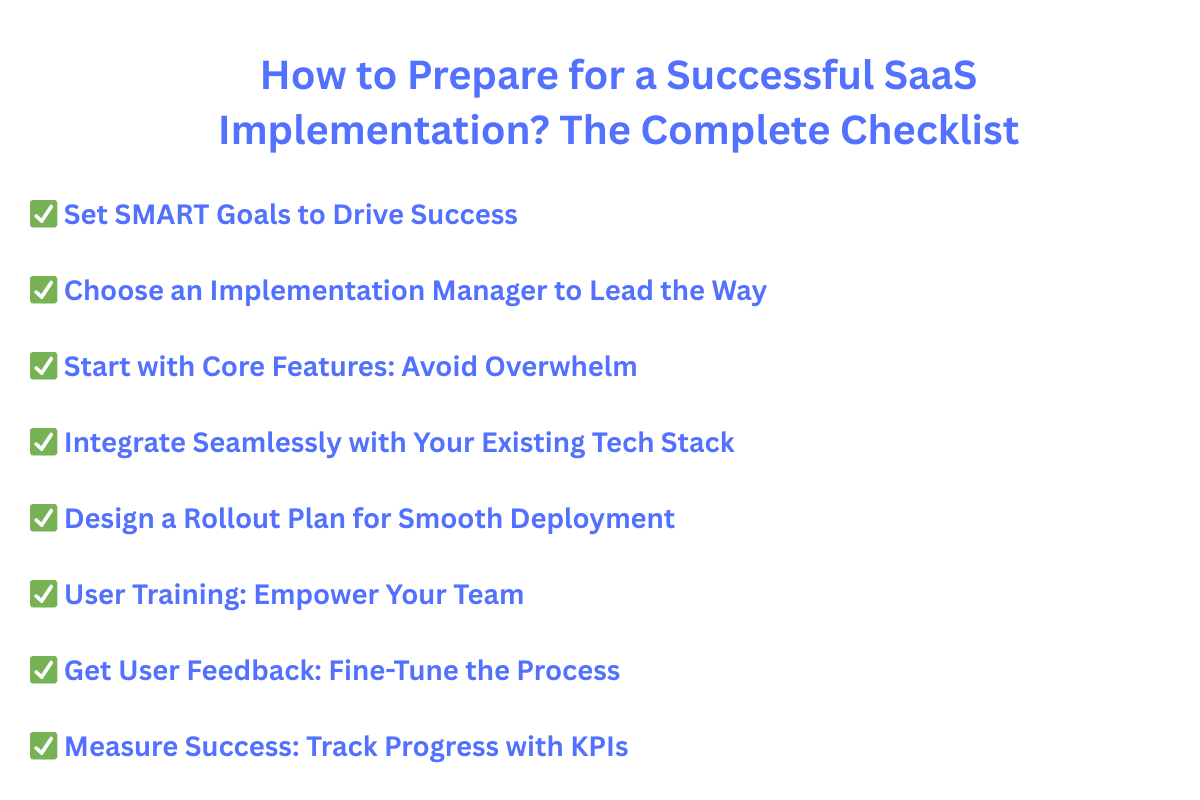
A successful SaaS implementation starts with careful planning. Setting clear goals, assembling the right team, and aligning the new software with your business needs can ensure a smooth transition and achieve long-term success.
1. Set SMART Goals to Drive Success
Establishing SMART goals—Specific, Measurable, Achievable, Relevant, and Time-bound—ensures your SaaS solution, including a customer relationship management aspect, aligns with your business objectives. Want to boost conversions by 20%? Track adoption progress regularly and set deadlines so your team can stay focused and motivated.
2. Choose an Implementation Manager to Lead the Way
A strong Implementation Manager keeps your project on track. This person handles resources, addresses problems, and ensures smooth communication between teams and vendors. With a dedicated leader, your deployment stays organized, efficient, and aligned with your business goals.
3. Start with Core Features: Avoid Overwhelm
Don’t dive into every feature at once—focus on core functionalities first. Before expanding into advanced features, introduce essential tools, like setting up campaigns in a marketing automation system. Gradual adoption ensures your team is confident and avoids information overload.
4. Integrate Seamlessly with Your Existing Tech Stack
Smooth integration with your current systems is essential. Whether syncing your CRM with Slack or automating data transfers via APIs, ensure everything works seamlessly. Testing early and collaborating with vendors can prevent integration issues, saving time and frustration.
5. Design a Rollout Plan for Smooth Deployment
A clear rollout plan is crucial for SaaS success. Align the timeline with business objectives and involve key stakeholders, including the development teams. Incorporate change management to ensure smooth adoption and adjust the plan based on team feedback to improve user satisfaction and minimize resistance.
6. User Training: Empower Your Team
Effective training is vital for SaaS adoption. Customize training with workshops, webinars, and hands-on sessions to meet your team's specific needs. This approach boosts confidence, ensures proper usage, and improves the likelihood of long-term software success.
7. Get User Feedback: Fine-Tune the Process
Keep an open channel for user feedback to improve the implementation process. Regular surveys and check-ins help identify pain points, adjust training, and align software usage with real business needs. This feedback loop ensures continuous improvement and boosts adoption rates.
8. Measure Success: Track Progress with KPIs
To gauge the success of your SaaS implementation, track KPIs that align with your goals: user adoption, system performance, and customer satisfaction. Regular monitoring and feedback help you stay on course, refine strategies, and identify improvement areas to ensure you get the most out of your SaaS investment.
What Are the Steps for a Flawless SaaS Implementation?
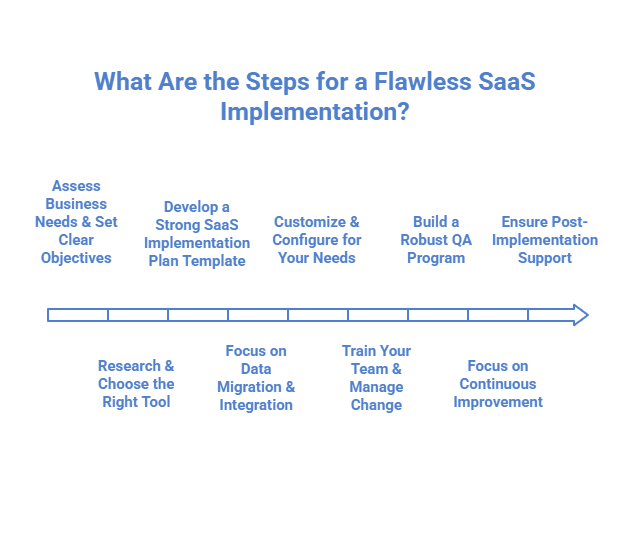
Implementing a SaaS solution can transform your business, but it requires a well-thought-out plan. Here’s how to get it right, fast and efficiently.
1. Assess Business Needs & Set Clear Objectives
Before diving in, identify your business goals and pain points. Work closely with your team—they’ll offer insights on what the software should solve. A clear understanding of your needs will ensure the SaaS tool aligns with your long-term vision.
2. Research & Choose the Right Tool
Don’t settle for just any SaaS solution. Look at key factors like features, scalability, and security. Check reviews and product demos, and get feedback from others in your industry to pick the best tool for your needs.
3. Develop a Strong SaaS Implementation Plan Template
A roadmap is essential. Outline timelines, allocate resources, and set measurable milestones. Involve key stakeholders to ensure alignment and that the plan covers everything from deployment to optimization.
4. Focus on Data Migration & Integration
Make sure your data migration is flawless—no data loss allowed. Plan secure migration and smooth integration with existing systems, like CRM or email marketing tools, to ensure a seamless transition.
5. Customize & Configure for Your Needs
While many SaaS tools come with standard features, customization is crucial to match your business processes. Focus on workflow management and data reporting to tailor the tool to your needs while keeping scalability in mind.
6. Train Your Team & Manage Change
Effective training is essential for adoption. Provide hands-on sessions and ensure your team understands the “why” behind the change. Address any concerns early and offer ongoing support to keep everyone on track.
7. Build a Robust QA Program
Test the tool before going live. A solid QA program ensures the software works as expected, is secure, and meets your needs. Regular testing will catch issues before they impact your business.
8. Focus on Continuous Improvement
Don’t stop once you’re live. Continuously evaluate the tool’s performance, gather user feedback, and stay up-to-date with new features. The more adaptable you are, the better you’ll leverage the SaaS tool’s full potential.
9. Ensure Post-Implementation Support
Post-launch, ongoing support is crucial for smooth adoption. Set up a system for quick fixes and communicate with your SaaS provider for updates and patches. Proactive support ensures continued success.
What Are the Challenges in SaaS Implementation?
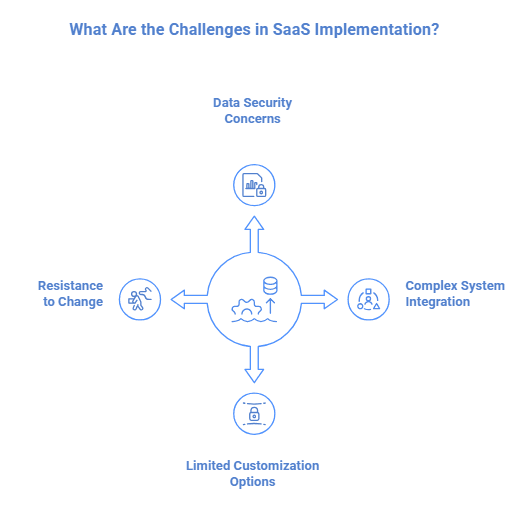
Implementing a new SaaS solution isn’t always smooth sailing. The process can be filled with obstacles, from security concerns to integration hiccups. But with the right plan, you can overcome these challenges and set yourself up for success. Let’s dive into the key hurdles you’ll need to tackle.
1. Data Security Concerns
Data security can’t be an afterthought. Protecting sensitive information is essential. Address risks by establishing strong data encryption, access controls, and compliance measures. Involve key stakeholders early to ensure everyone is aligned, and you’ll build trust and a smoother transition.
2. Complex System Integration
Getting your new SaaS tool to play nice with your existing systems can be a pain. The key? Early planning for data migration and API setups. When done right, the integration feels seamless and boosts adoption, letting your team hit the ground running.
3. Limited Customization Options
SaaS tools often come with pre-set features that may not perfectly align with your business needs. Knowing which features matter most to you and where compromises can be made is essential. Being transparent from the start helps prevent frustration and keeps the project on track.
4. Resistance to Change
No one likes change, but good change management can make all the difference. Start by addressing concerns early and clearly showing the new system's benefits. Keep communication open and support available, and soon, your team will embrace the shift without hesitation.
What Are the Best Practices for a Smooth SaaS Implementation?
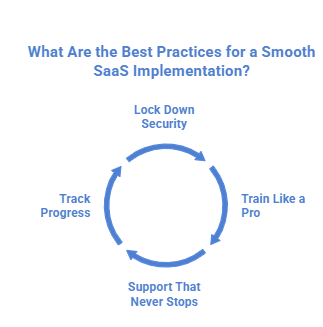
Implementing a new SaaS tool isn’t just about getting it up and running—it’s about ensuring your team adopts it smoothly, securely, and effectively. Follow these best practices for a seamless SaaS rollout that delivers accurate results.
1. Lock Down Security from the Start
Security is non-negotiable. Before rolling out a SaaS solution, like a CRM or project management tool, assess your tech stack for vulnerabilities. Implement strong data encryption and user access controls to protect sensitive information. Make security a team effort—get everyone on the same page to stay ahead of potential risks. By taking these precautions, you comply with regulations and build customer trust from day one.
2. Train Like a Pro, Not a Chore
Great software is only as good as the team using it. Comprehensive user training is key to successful adoption. For example, when launching a new tool like Slack, start with the basics, then dive into advanced features like channels and integrations. Keep training engaging with real-life examples, and offer refresher sessions to keep skills sharp. The more confident your team is, the smoother the transition.
3. Support That Never Stops
Don’t let your team drown in questions after launch. Establish continuous support and create feedback loops to address issues as they arise. For example, if your customer support team uses a new helpdesk tool like Zendesk, set up regular check-ins to track progress and gather feedback. This ensures smoother adoption and gives your team the confidence to work through any challenges.
4. Track Progress, Tweak as You Go
Monitor key performance indicators (KPIs) regularly to monitor how your SaaS tool is performing. Are users adopting it? Are there bottlenecks? For example, with a new invoicing tool like QuickBooks, track usage rates and look for any roadblocks. Regular check-ins with the implementation team and end-users allow you to catch issues early, ensuring the tool stays aligned with your business goals and continuously improves.
SmartCue: Streamline Your SaaS Implementation Like a Pro
Successful SaaS implementation is all about smooth adoption, and SmartCue makes this easier with its personalized demos. These tailored demos help teams quickly understand the value of new SaaS solutions, speeding up the learning curve and improving adoption.
Instead of relying on generic walkthroughs, SmartCue allows your team to experience a demo that speaks directly to their needs, ensuring they hit the ground running. Focusing on user engagement and practical training, SmartCue simplifies the transition and keeps everyone aligned.
Here's how you can create personalized demos that engage leads, shorten your sales cycle, and drive conversions in just a few minutes.
Step 1: Sign Up & Install the Chrome Extension
Get started with SmartCue’s free trial and set up your workspace in minutes.
Step 2: Capture & Build Your Demo
Use SmartCue to record your product walkthrough or start from a ready-made template.
Step 3: Customize for Clarity & Engagement
Add tooltips, text overlays, and interactive elements to guide prospects through your product’s value—without overwhelming them.
Step 4: Share & Track Engagement
Send your demo link, then track which features prospects engage with the most, so you know exactly what resonates.
Try it out with a 14-day free trial—see how SmartCue’s personalized demos can transform your SaaS implementation experience.
Conclusion
Implementing a SaaS solution can transform your business, making processes smoother, faster, and more efficient. The transition to a new system becomes seamless with the proper implementation plan and best practices in place.
But it’s not just about putting a tool in place—it’s about change management. Regular feedback and training keep your team engaged and adaptable, ensuring a smooth adoption and faster ramp-up.
A successful SaaS implementation goes beyond solving immediate problems—it enhances customer satisfaction, strengthens relationships, and drives long-term growth.
By continuously improving and aligning the system with your business goals, you’re setting your company up for sustainable success. Stick to a solid plan, follow proven steps, and watch your business evolve and thrive.
Frequently Asked Questions
What is the first step in a SaaS implementation plan?
The first step in an implementation plan for SaaS is to be clear about what you want to achieve. This means you should set goals and know the main tasks. Doing this helps every team and team member who has a part in the project work together. It gives the project a solid base and makes sure everyone works toward the exact business needs. This planning method also helps prepare for good user adoption and makes everything go well from the start.
How long does it typically take to implement a SaaS solution?
The time needed to set up a SaaS solution will differ for each business. It depends on how complicated the project is and how ready the company is. For most, it takes anywhere from a few weeks to a few months. Things like user training, data migration, and how the system connects with other tools can all affect how long it takes.
How to prepare a SaaS implementation plan?
To make an implementation project plan for a SaaS project, start by writing down the main goals and setting up when things need to be done. Meet with everyone involved to find out what they need, who will do what, and how you will all keep in touch. Find ways to watch for risks and match your steps with the business's wants. Doing all this can help you transition smoothly and achieve a successful implementation.

